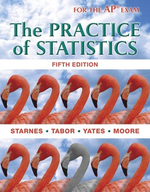Solution Found!
Blink When two lights close together blink alternately, we see one light moving back and
Chapter 8, Problem 64(choose chapter or problem)
When two lights close together blink alternately, we “see” one light moving back and forth if the time between blinks is short. What is the longest interval of time between blinks that preserves the illusion of motion? Ask subjects to turn a knob that slows the blinking until they “see” two lights rather than one light moving. A report gives the results in the form “mean plus or minus the standard error of the mean.” Data for 12 subjects are summarized as \(251 \pm 45\) (in milliseconds).
(a) Find the sample standard deviation \(s_x\) for these measurements. Show your work.
(b) A hasty reader believes that the interval given in the report is a 95% confidence interval for the population mean. Find the actual confidence level for the given interval.
Questions & Answers
QUESTION:
When two lights close together blink alternately, we “see” one light moving back and forth if the time between blinks is short. What is the longest interval of time between blinks that preserves the illusion of motion? Ask subjects to turn a knob that slows the blinking until they “see” two lights rather than one light moving. A report gives the results in the form “mean plus or minus the standard error of the mean.” Data for 12 subjects are summarized as \(251 \pm 45\) (in milliseconds).
(a) Find the sample standard deviation \(s_x\) for these measurements. Show your work.
(b) A hasty reader believes that the interval given in the report is a 95% confidence interval for the population mean. Find the actual confidence level for the given interval.
ANSWER:Step 1 of 2
(a)
Given,
Sample mean, \(\bar{x}=251\)
Standard error of the sample mean, \(S E_{x}=45\)
Sample size = 12
We know the equation for The standard error of the sample mean is,
\(S E_{x}=\frac{s_{x}}{\sqrt{n}}\)
Where \(s_{x}\) is the sample standard deviation.
We can calculate the sample standard deviation by rearranging the above equation, ie;
\(s_x=SE_x\times\sqrt{n}=45\times\sqrt{12}=155.884=155.88\)
